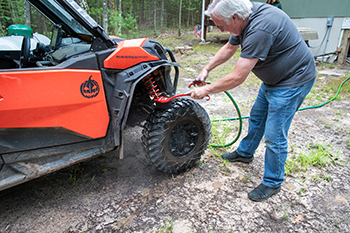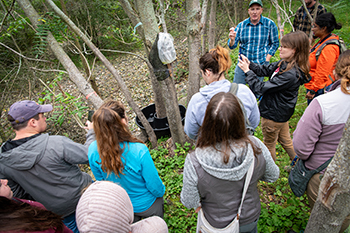NotMISpecies webinars take deep dive into invasive species in Michigan
By JOANNE FOREMAN
Invasive Species Program communications specialist
Michigan Department of Natural Resources
When invasive species make the Michigan headlines, it's usually bad news – a new, tree-damaging insect or a new aquatic plant infesting lakes.
Despite public expectation, there is rarely a quick fix for these infestations.
Invasive species are, by definition, new to an environment and threatening due to their ability to quickly spread, reproduce or otherwise disrupt ecosystems. Predators that kept these species in check in their native ranges generally don’t arrive here with them.

Finding effective ways to manage invasive species while limiting harm to native plants and animals is slow work, sometimes involving years of pesticide or biological control trials or drawn-out, labor-intensive treatment and removal efforts. Such work doesn’t make the headlines, but it is the daily business of a small, dedicated community of field biologists, technicians, university researchers and volunteers across the state.
They are the staff and numerous partners of Michigan’s Invasive Species Program, a joint effort of the Michigan departments of Natural Resources; Agriculture and Rural Development; and Environment, Great Lakes, and Energy.
Shining a light on their progress is the primary goal of the NotMISpecies webinar series.
Initiated in 2021, these monthly, hourlong webinars are designed to inform people about emerging issues, current research and available programs relevant to invasive species in the state and the Great Lakes region. Question and answer sessions and links to resources help attendees get the most out of each presentation.
From the experts
The webinar format provides a useful forum for sharing work in progress and helping people understand more about invasive species prevention and control straight from those doing the actual work.
Though the work is often technical in nature, experts like Dr. Marianna Szucs, who works with biological control agents in Michigan State University’s Department of Entomology, help make it accessible to everyone. In webinars discussing her research into invasive knotweed and swallowwort biological controls, she carefully describes the over-15-year process of selecting appropriate insect biocontrol control agents and obtaining permits to release them.
“People are concerned because there are some stories about biocontrol agents getting out of control,” said Szucs. “Early on, in the 18th and 19th centuries, there were no regulations, so people were just moving things around, like mongooses and ferrets to control rats, and that’s where the horror stories come from.”
|

Searching for solutions
Sometimes invasive species control efforts are multifaceted, like the gamut of deterrent technologies being developed for the Brandon Road Interbasin project. The project is designed to prevent invasive bighead, silver and black carp from entering the Great Lakes, described by Tammy Newcomb of the Michigan Department of Natural Resources in “Big, Hungry Fish.”
A multipronged approach often is necessary when trying to find effective control measures while at the same time preventing an invasive species from spreading to larger areas. Webinars on the multijurisdictional work to control grass carp in Lake Erie and the ongoing work to limit the spread of invasive red swamp crayfish in Michigan highlight the necessity of adaptive management in control efforts.
As Lucas Nathan, DNR aquatic species and regulatory affairs unit manager, explains in “Lobster Mobsters,” “We are implementing strategies we believe have the best chance to get us to the goal of eradication. Along the way, we continue to address uncertainties or questions about red swamp crayfish populations through various research projects, and we use that information to change our control strategies accordingly.”
Research on red swamp crayfish population genetics will be featured in an upcoming webinar, when Dr. Jared Homola of the U.S. Geological Survey Wisconsin Cooperative Fishery Research Unit presents “Genes on the Move: Understanding Red Swamp Crayfish Spread in Southeastern Michigan” (9 a.m. Thursday, Sept. 12).
An ounce of prevention
As the adage goes, prevention – especially when it comes to invasive species – is much less expensive than finding a cure. NotMISpecies webinars often highlight ways people can prevent the unintended introduction or spread of invasive species.
|

In “To Infinity … and Beyond (Beauty),” Shelly Stusick of the Northwest Michigan Invasive Species Network describes the Go Beyond Beauty program, which recognizes garden professionals and community members who have committed not to sell or use high-priority ornamental invasive plants.
Staff members from the North Country Cooperative Invasive Species Management Area also used the webinar opportunity to share their innovative outreach program for off-road vehicle enthusiasts in “Dirt Never Hurt, But Invasive Species Do.”
“Right after the presentation, I got calls and emails from people in other areas, even other states, who had seen the webinar and wanted to get materials or set up a similar program,” said Vicki Sawicki, formerly of NCCISMA, now working with the DNR.
A diverse audience
An analysis of data from 2021 to 2023 showed an average of 25% of those who joined live broadcasts of NotMISpecies webinars were state employees, 21% listed no affiliation, 13% represented local governments, 13% were affiliated with environmental organizations and 4% were from other states or countries. Others were affiliated with industries, universities, federal agencies, tribes, K-12 schools or the news media.
Live attendance at each webinar averages just over 200, while views of recorded webinars average 150 per program. To date, the webinar with the highest live attendance (353 live viewers) is “Where the Sidewalk Ends,” a presentation by Lawrence Sobson, DNR urban forester, on choosing enduring, noninvasive trees for urban landscapes.
|

Sobson’s presentation is also a good example of how audiences shift based on the topic, with local units of government, a target audience for the session, accounting for 27% of total viewers, up 14% from the average.
While reaching a few hundred people each month may not be everyone’s idea of success, for the organizers of the NotMISpecies webinar series, it’s worth the effort – especially knowing that those viewers can carry prevention tips and best practices to even more people.
According to Ryan Blazic of the Michigan Department of Environment, Great Lakes, and Energy’s Environmental Support Division, which produces the webinar on the Zoom platform, “Viewership is consistent, and with 37 programs to date, NotMISpecies is the longest-running EGLE outreach series.”
Emerging issues
“Overall, the webinars have given us a space to share our work and, when needed, provide important background information on new species emerging in Michigan,” said Christina Baugher, DNR aquatic invasive species biologist and part of the webinar team.
In May, Billy Keiper of EGLE’s Water Resources Division provided an update on efforts to eradicate hydrilla, an invasive aquatic plant found in 2023 in two private residential ponds in southwest Michigan.
|

Earlier webinars provided developing news on beech leaf disease, spotted lanternfly, didymo and balsam woolly adelgid, helping viewers to properly identify the species and report any detections.
“The webinars can be helpful in many ways,” said Baugher. “If you’re looking for expert information on a particular species, hoping to find ways to get involved in preventing invasive species’ spread or just curious about emerging research, you’ll find it by tuning in to a live webinar or viewing one of the dozens of recorded sessions.”
Recordings of previous webinars and registration links for upcoming sessions are available on the NotMISpecies webpage.
Michigan’s Invasive Species Program coordinates and supports invasive species initiatives across the state and provides support through the Michigan Invasive Species Grant Program.
|
Check out previous Showcasing the DNR stories in our archive at Michigan.gov/DNRStories. To subscribe to upcoming Showcasing articles, sign up for free email delivery at Michigan.gov/DNREmail.
Note to editors: Contact: Casey Warner or DNR-Public-Info@Michigan.gov. Accompanying photos and a text-only version of this story are available below for download. Caption information follows. Credit Michigan Department of Natural Resources, unless otherwise noted.
Text-only version of this story.
CISMA: Coordinators from several of Michigan’s cooperative invasive species management areas learn how to identify spotted lanternfly on an infested site in Oakland County.
Incision: Michigan Department of Natural Resources fisheries biologist Cleyo Harris makes an incision into the stomach cavity of a grass carp so the fish can be tagged with a transmitter.
ORV: Removing dirt and debris from off road vehicles after a ride can help to prevent the spread of invasive species between trails.
Planting: Lawrence Sobson, Michigan Department of Natural Resources urban forester, helps a volunteer with a planting project in Warren, Michigan.
Survey: The Michigan Department of Environment, Great Lakes, and Energy’s Billy Keiper conducts a survey for aquatic invasive plants along the shoreline in northeast Michigan. (Photo courtesy of EGLE)
Trap: Lucas Nathan of the Michigan Department of Natural Resources Fisheries Division holds a red swamp crayfish trap at a pond in Novi, Michigan.
Tree: A volunteer selects a tree to plant on an urban landscape at a Greening of Detroit event.
|